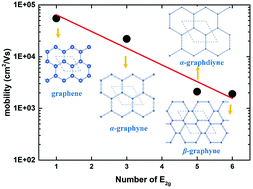The origin of intrinsic charge transport for Dirac carbon sheet materials: roles of acetylenic linkage and electron–phonon couplings†
Abstract
Within the past few years, intriguing graphene Dirac cones have attracted intense interest in novel two-dimensional (2D) Dirac materials as ultrahigh-mobility functional materials. In this work, the phonon-limited charge transport properties of α-graphyne (α-GY), α-graphdiyne (α-GDY), and β-graphyne (β-GY) were investigated using the Boltzmann transport equation within the first-principles framework while considering the electron–phonon coupling (EPC). Despite all three investigated compounds being 2D Dirac carbon materials, each demonstrated distinctly different carrier mobilities by one order of magnitude (2.2 × 104 cm2 V−1 s−1 for α-GY, 2.1 × 103 cm2 V−1 s−1 for α-GDY and 1.9 × 103 cm2 V−1 s−1 for β-GY at room-temperature and a carrier connection of n ∼ 3 × 1012 cm−2). The essential differences in the mobilities of these materials originated from the acetylenic linkage limiting the group velocity and the E2g phonon modes limiting the scattering time. For example, a few uniformly equivalent acetylenic linkages and E2g phonon modes tend to generate high mobilities. A simple mobility relationship was determined using the number of E2g photon modes, allowing for a quick estimation of the mobilities for Dirac materials. α-GY was identified as a promising alternative to graphene for next generation nanoelectronic devices.



 Please wait while we load your content...
Please wait while we load your content...